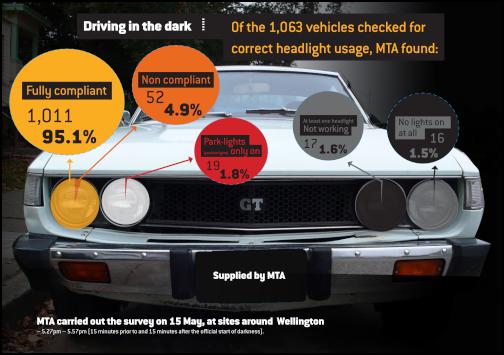Motorists switched on for darker nights on the roads

Media Release 20 May 2013
Motorists
switched on for darker nights on the roads
As
the shorter days of winter approach, the Motor Trade
Association (MTA) says the majority of drivers are using
their headlights appropriately – although a number are
placing themselves, and other road-users, at risk.
In a roadside survey of more than 1,000 vehicles conducted last week, MTA staff found almost 5 percent of motorists were improperly using their headlights for the conditions. These vehicles had a fault with one or more of their headlights, had park lights (position lights) only on, or most worryingly, had no lights on at all.
Motorists are required by law to use their headlights during the ‘official hours of darkness’: from 30 minutes after sunset to 30 minutes before the next sunrise, or at any other time when you can't clearly see a person or vehicle 100 metres away.
For many drivers though, the periods leading up to or immediately following the time of actual darkness provide the biggest challenge, MTA spokesman Hamish Stuart says. During these periods it is not easy or practical for drivers to determine when it is ‘officially’ dark; most rely on common sense to tell them when they need to have their headlights on.
“The problem is though, that for most of the time in New Zealand, these lead-up periods fall across the peak traffic times of 7.00 – 9.00am and 5.00 – 7.00pm. Certainly in our quick study, we saw the highest levels of non-compliance just before it was officially dark. Unsurprisingly the highest number of injury accidents occurs on our roads during these periods,” Stuart says.
With the likelihood of poorer visibility increasing as we approach winter, MTA says all drivers need to ensure their lights are working properly, and that they turn them on.
“Parking or position lights are there for just that purpose – only use them when your vehicle is stationary. If you are on the road, do all you can to ensure other road users, including pedestrians, can see you and you can see them,” he says.
“It’s much better to have other road users remarking you having your lights on earlier in the day than not – they’re talking because they see you. It’s the cars people don’t see that cause the crashes.”
Vehicles surveyed 15 May Wellington – 5.27pm – 5.57pm (15 minutes prior to and 15 minutes after the official start of darkness). Visibility was less than 100 metres at that time.
| Total vehicles surveyed | 1,063 | |
| Fully compliant | 1,011 | 95.1% |
| Non compliant | 52 | 4.9% |
| Park-lights (position lights) only on | 19 | 1.8% |
| At least one headlight not working | 17 | 1.6% |
| No lights on at all | 16 | 1.5% |
The
Ministry of Transport has further information on incidence
of traffic accidents according to the time of the day: http://www.transport.govt.nz/research/MotorVehicleCrashesinNewZealand2011/
ENDS


 Tātaki Auckland Unlimited: Iconic Auckland Eats 2025 Top 100 Dishes Revealed After Record Number Of Nominations
Tātaki Auckland Unlimited: Iconic Auckland Eats 2025 Top 100 Dishes Revealed After Record Number Of Nominations Hugh Grant: What Is Cloud Migration And How Does It Work
Hugh Grant: What Is Cloud Migration And How Does It Work Property Council New Zealand: Hiwa Recreation Centre Takes Top Award At 2025 Property Industry Awards
Property Council New Zealand: Hiwa Recreation Centre Takes Top Award At 2025 Property Industry Awards Great Journeys New Zealand: Scenic Plus Winter Menu Launched
Great Journeys New Zealand: Scenic Plus Winter Menu Launched Tourism New Zealand: Tourism New Zealand Invites The World To Find Their 100% Pure New Zealand In New Global Campaign
Tourism New Zealand: Tourism New Zealand Invites The World To Find Their 100% Pure New Zealand In New Global Campaign Bill Bennett: Comcom warns 2degrees over satellite marketing
Bill Bennett: Comcom warns 2degrees over satellite marketing


